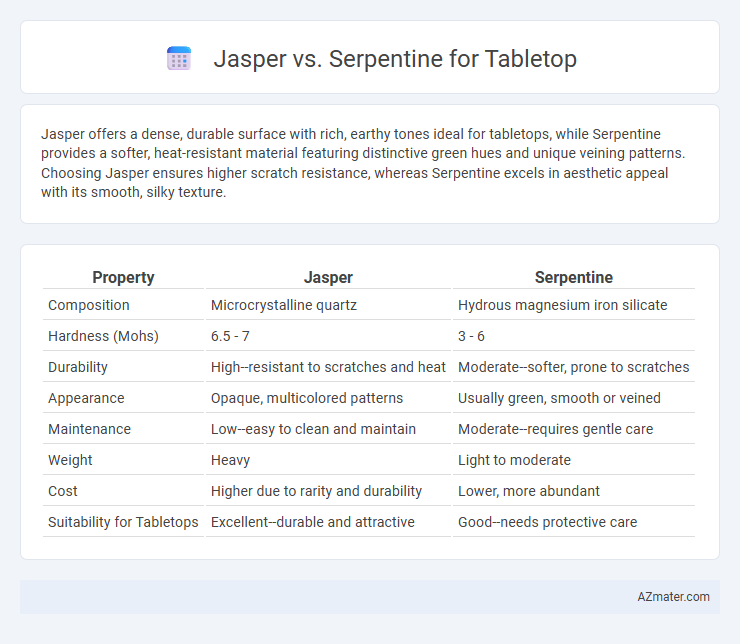Jasper offers a dense, durable surface with rich, earthy tones ideal for tabletops, while Serpentine provides a softer, heat-resistant material featuring distinctive green hues and unique veining patterns. Choosing Jasper ensures higher scratch resistance, whereas Serpentine excels in aesthetic appeal with its smooth, silky texture.
Table of Comparison
| Property | Jasper | Serpentine |
|---|---|---|
| Composition | Microcrystalline quartz | Hydrous magnesium iron silicate |
| Hardness (Mohs) | 6.5 - 7 | 3 - 6 |
| Durability | High--resistant to scratches and heat | Moderate--softer, prone to scratches |
| Appearance | Opaque, multicolored patterns | Usually green, smooth or veined |
| Maintenance | Low--easy to clean and maintain | Moderate--requires gentle care |
| Weight | Heavy | Light to moderate |
| Cost | Higher due to rarity and durability | Lower, more abundant |
| Suitability for Tabletops | Excellent--durable and attractive | Good--needs protective care |
Introduction: Jasper vs Serpentine for Tabletop
Jasper and serpentine are popular choices for tabletop surfaces due to their unique visual appeal and durability. Jasper, a form of chalcedony, offers rich, vibrant patterns and exceptional hardness, making it resistant to scratches and heat. Serpentine, known for its smooth texture and greenish tones, provides a softer, more luxurious look but may require more maintenance due to its relative softness compared to jasper.
Visual Appeal: Color and Patterns
Jasper showcases a rich spectrum of colors including deep reds, browns, yellows, and greens, often featuring intricate, swirling patterns that add a bold, earthy aesthetic perfect for tabletop surfaces seeking a warm and dynamic look. Serpentine offers a striking visual with its vibrant green hues and smooth, waxy texture, frequently displaying marbled or mottled patterns that bring a natural, calming elegance to tabletops. Both stones provide unique color palettes and patterns, with Jasper emphasizing vibrant complexity and Serpentine delivering a cool, serene appearance ideal for enhancing tabletop decor.
Durability and Hardness Comparison
Jasper, with a Mohs hardness of 6.5-7, offers excellent durability and resistance to scratches, making it a robust choice for tabletop surfaces. Serpentine ranks lower on the hardness scale at 2.5-5, which makes it more prone to dents and surface wear under heavy use. For tabletop applications requiring long-lasting resilience, jasper provides superior hardness and overall durability compared to serpentine.
Maintenance and Care Requirements
Jasper requires minimal maintenance with occasional cleaning using a soft cloth and mild soap to preserve its polished surface, as it is a durable and hard stone resistant to scratches and chips. Serpentine demands more careful care due to its relative softness and susceptibility to heat and acid damage; it should be cleaned gently with pH-balanced cleaners and kept away from direct sunlight to avoid fading. Both stones benefit from periodic sealing to prevent stains, but Jasper's low porosity makes it generally easier to maintain for tabletop use.
Stain and Scratch Resistance
Jasper exhibits excellent stain resistance due to its dense, non-porous nature, making it ideal for tabletop surfaces prone to spills. Serpentine, while visually striking with its unique patterns, tends to be softer and more susceptible to scratching and staining compared to jasper. Choosing jasper for tabletops ensures longer-lasting durability and easier maintenance in everyday use.
Price and Availability
Jasper is generally more affordable and widely available in various sizes and colors, making it a popular choice for tabletop projects. Serpentine, being rarer and often sourced from specific regions, tends to have a higher price point and limited availability. Both stones offer unique aesthetic properties, but budget-conscious buyers often prefer jasper for its cost-effectiveness and easier procurement.
Suitability for Kitchen vs Dining Tables
Jasper's dense, durable composition and resistance to stains make it an excellent choice for kitchen tables that face frequent spills and heavy use. Serpentine, with its unique swirling patterns and softer surface, is better suited for dining tables where aesthetic appeal and lighter use are prioritized over high durability. Selecting Jasper for a kitchen setup ensures long-term functionality, while Serpentine enhances the visual elegance of a dining area without the same level of wear resistance.
Environmental and Ethical Considerations
Jasper mining typically involves large-scale quarrying that can disrupt local ecosystems but is often regulated for sustainable extraction, whereas serpentine extraction poses environmental concerns due to potential asbestos contamination, requiring stringent safety measures to protect workers and surrounding habitats. Ethical considerations for jasper emphasize sourcing from suppliers who follow fair labor practices and minimize ecological damage, while serpentine's hazardous nature demands careful handling and transparent supply chains to ensure human health and environmental safety. Choosing jasper over serpentine for tabletop materials reduces health risks and supports more sustainable and ethically responsible production practices in the stone industry.
Popular Design Styles and Trends
Jasper and serpentine are both highly favored in tabletop design due to their unique color variations and natural patterns. Jasper's earth-toned hues and speckled appearance complement rustic and bohemian design styles, while serpentine's smooth, flowing green and black veining suits modern and organic aesthetics. Current trends emphasize incorporating these stones for their durability and distinctive visual appeal in luxury and artisanal tabletop creations.
Final Verdict: Which Stone is Best for Your Tabletop?
Jasper offers exceptional durability and vibrant, earthy patterns ideal for high-traffic tabletops, making it a popular choice for those seeking a robust yet visually striking surface. Serpentine provides a unique, serpentine veining with a softer touch but requires more care due to its comparative susceptibility to scratches and stains. For a long-lasting, low-maintenance tabletop with dynamic aesthetics, jasper is generally the superior option, while serpentine suits those prioritizing distinctive appearance over toughness.

Infographic: Jasper vs Serpentine for Tabletop
 azmater.com
azmater.com